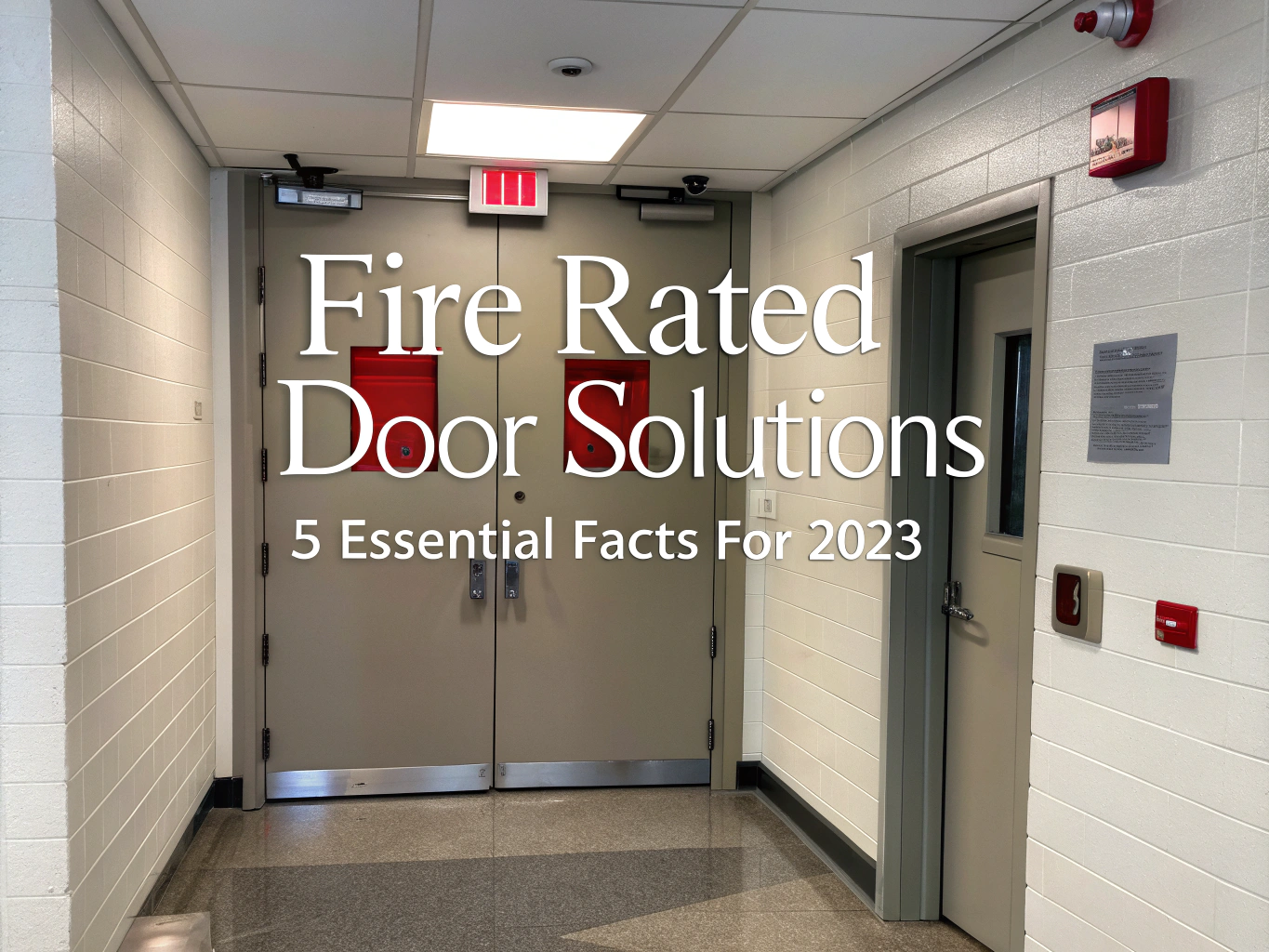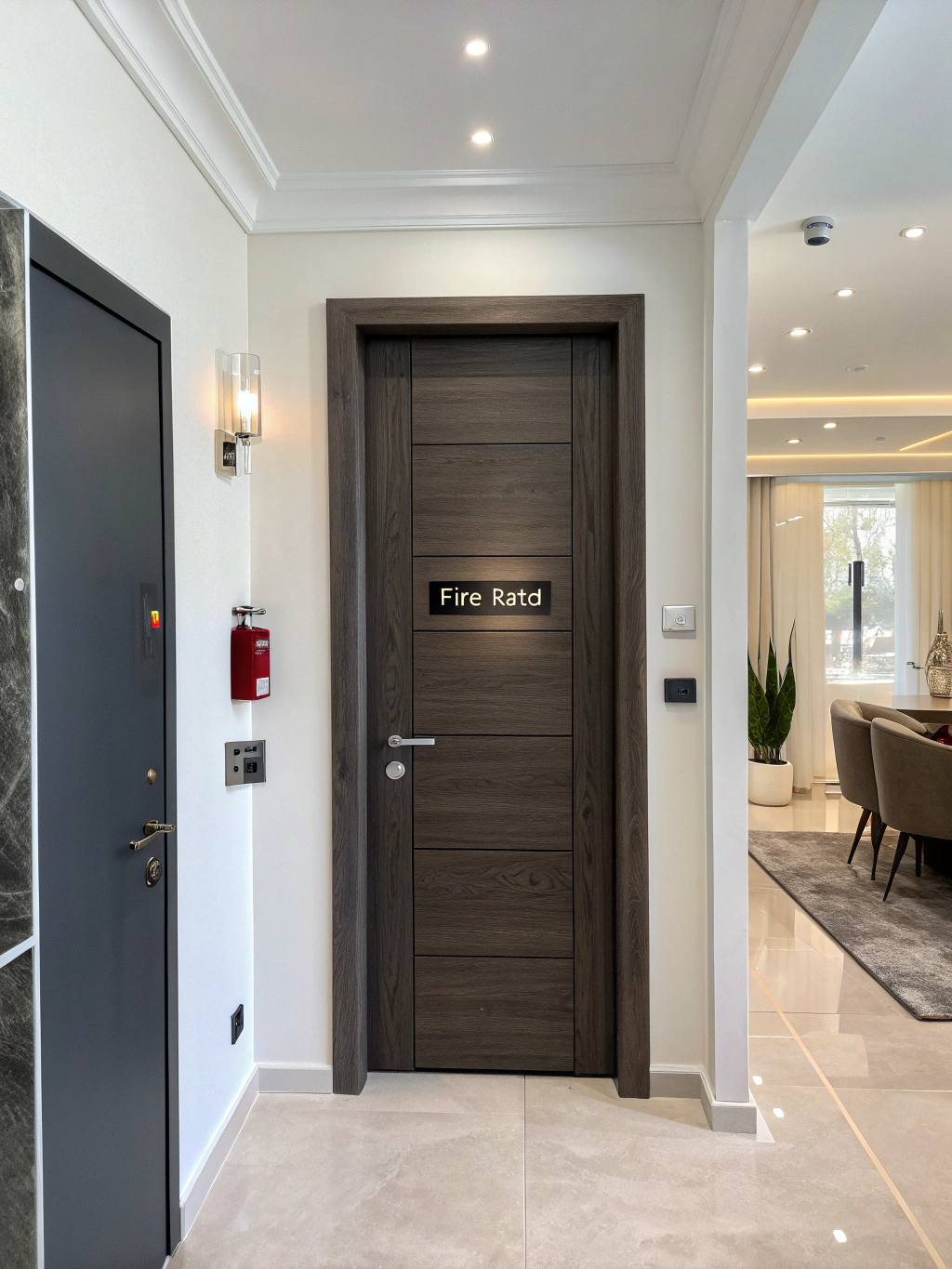
Ever wondered how a simple door can shield you from a blazing threat? Every year, fire rated doors save countless lives by delaying the spread of flames and smoke. These innovative barriers are more than just a building regulation; they are a cornerstone of safety. Let’s explore what makes them essential and how they’re evolving in 2025.
Fire rated doors represent a critical component of building safety infrastructure, with the global market valued at approximately USD 47.2 billion in 2023 and projected to exceed USD 64.8 billion by 2032. These specialized doors serve as vital barriers against fire spread, buying precious evacuation time and protecting property, while their implementation continues to be driven by increasingly stringent safety regulations and growing awareness of fire prevention measures.
Introduction
Fire rated doors represent a critical safety component in modern buildings, designed specifically to contain fires and prevent the spread of smoke and flames for designated time periods. The global fire rated door market, valued at approximately USD 47.2 billion in 2023, is projected to grow at a CAGR of 3.3-5.5% through 2032, driven by stricter building codes, increased urbanization, and growing awareness of fire safety measures across residential and commercial sectors.
1. What Is a Fire Rated Door? Key Features and Certification
A fire rated door is a specially engineered door designed to resist fire for specific timeframes, typically 20, 60, or 90 minutes. These doors function as barriers that prevent flames, smoke, and heat from spreading between compartments in a building, providing crucial time for evacuation and emergency response.
The effectiveness of fire rated doors relies on several key components:
- Intumescent seals that expand when exposed to heat, sealing gaps around the door
- Fire-resistant core materials (steel, treated wood, or composite materials)
- Self-closing mechanisms to ensure the door remains shut during a fire
- Heat-resistant glass panels (when applicable)
- Fire-rated frames and hardware that maintain structural integrity
Time ratings indicate how long a door can withstand standard fire test conditions. Common ratings include:
- 20-minute: Basic protection, often used for residential applications
- 60-minute: Medium protection for commercial settings
- 90-minute: High protection for critical areas like stairwells and elevator shafts
For a door to be considered fire-rated, it must undergo rigorous testing and certification by recognized authorities. In the United States, the National Fire Protection Association (NFPA) and International Fire Code establish standards that manufacturers must meet. Certified doors display permanent labels indicating their fire rating, manufacturer information, and testing agency.

2. Market Growth and Industry Trends
The fire rated door market is experiencing substantial growth globally. According to Research and Markets, the market is projected to reach USD 64.8 billion by 2032, growing at a CAGR of 3.3-5.5%. This growth is driven by several key factors:
Regional Market Differences
Market dynamics vary significantly across regions:
- North America: The fastest-growing region with a 5.9% CAGR (2023-2031), driven by strict safety regulations and smart building integration
- Europe: The largest market by value, with strong emphasis on building renovations and regulatory compliance
- Asia-Pacific: Experiencing rapid growth due to massive infrastructure development and urbanization, particularly in China and India
The U.S. market alone for fire-resistant doors was valued at USD 3.2 billion in 2023 and is expected to reach USD 4.4 billion by 2029, according to Focus Reports.
Key Growth Drivers
Several factors are fueling market expansion:
- Rapid urbanization and infrastructure development in emerging economies
- Increasingly stringent building safety codes and regulations
- Growing awareness of fire safety measures
- Rising insurance requirements for commercial and residential properties
Technological Innovations
The industry is seeing significant technological advancements, including:
- Smart fire doors with IoT integration for remote monitoring and control
- Automatic closing systems triggered by fire alarm activation
- Improved materials offering better insulation and longer fire resistance
- Aesthetically pleasing designs that don’t compromise safety standards
3. Applications Across Different Sectors
Fire rated doors serve critical safety functions across various sectors, each with specific requirements and applications.
Residential Applications
In residential settings, fire rated doors are increasingly common in:
- Doors between attached garages and living spaces
- Multi-family housing units (apartments and condominiums)
- Interior doors in larger homes, particularly near kitchens or heating equipment
- Basement access points
Residential applications typically require 20-minute fire ratings, though local building codes may vary. Many homeowners now choose fire rated doors for added safety and potential insurance benefits.
Commercial and Public Building Installations
Commercial buildings have more extensive requirements for fire rated doors:
- Office buildings: stairwells, corridors, and departmental separations
- Hotels: guest room entrances, stairwells, and service areas
- Hospitals: patient rooms, corridors, and hazardous areas
- Schools: classrooms, laboratories, and assembly areas
- Shopping centers: store entrances, back-of-house areas, and emergency exits
These applications often require 60 to 90-minute ratings and must comply with accessibility standards alongside fire safety requirements.
Industrial Uses and Specialized Settings
Industrial environments present unique fire safety challenges:
| Setting | Common Applications | Typical Rating |
|---|---|---|
| Manufacturing facilities | Between production areas and storage | 60-90 minutes |
| Warehouses | Compartmentalization of storage areas | 90+ minutes |
| Data centers | Server room protection | 60-90 minutes |
| Chemical plants | Hazardous material containment | 90+ minutes |
Critical installation points across all sectors include stairwells, corridors, and elevator lobbies – areas essential for safe evacuation during emergencies. These locations typically require the highest fire ratings and most reliable self-closing mechanisms.
According to GM Insights, the commercial sector currently dominates the market, but residential applications are growing at a faster rate as awareness increases.
4. Regulatory Standards and Compliance Requirements
Navigating the regulatory landscape for fire rated doors requires understanding various standards and compliance processes.
Global Fire Safety Regulations
Fire safety regulations vary by country but share common principles:
- United States: NFPA 80 and International Building Code (IBC) establish requirements
- European Union: EN 1634 standards govern testing and certification
- United Kingdom: Building Regulations Document B covers fire safety
- Australia: National Construction Code (NCC) sets standards
- Canada: National Building Code of Canada (NBC) provides requirements
Mandatory Installation Locations
Most building codes require fire rated doors in specific locations:
“Fire rated doors must be installed at barriers between different occupancy types, in exit stairwells, corridors providing access to exits, and at openings in fire-rated walls. These requirements apply to both new construction and renovation projects where fire-rated assemblies are required.”
The specific requirements vary based on building type, occupancy classification, and local amendments to model codes.
Certification and Inspection Processes
For a fire rated door to be compliant, it must undergo:
- Testing by an accredited laboratory according to standardized fire test methods
- Certification by a recognized agency that verifies performance
- Labeling with permanent marks indicating rating, manufacturer, and certifying agency
- Proper installation by qualified personnel following manufacturer specifications
- Regular inspection and maintenance to ensure continued performance
Many jurisdictions now require annual or semi-annual inspections of fire rated doors in commercial and public buildings, with documentation maintained for code enforcement officials.
Insurance Implications
Properly installed and maintained fire rated doors can have significant insurance benefits:
- Reduced premium costs for commercial property insurance
- Potential homeowner insurance discounts
- Improved risk assessment ratings for commercial properties
- Mitigation of liability concerns in multi-tenant buildings
According to Grand View Research, insurance incentives are becoming an increasingly important driver for fire rated door installations, particularly in commercial settings.
5. Top Fire Rated Door Products for 2025
When selecting fire rated doors, several factors should guide your decision, including required fire rating, door style, material preferences, and budget constraints. Here are some top-rated options currently available on the market:
These fire rated door solutions offer excellent protection for various applications:

Fire Rated Elegant MDF Door
- 20-minute fire rating for safety assurance
- Primed for easy painting
- Elegant 2-panel Archtop design
- Right-hand in-swing for versatile fitting
- 32×80 inches, perfect for standard doorways.

Fire Rated Attic Access Door
- Designed for ceiling and wall installation
- Fire rated for safety and compliance
- Multiple size options for various needs
- Recessed panel for a clean look
- Perfect for electrical and plumbing access.

Double Fire Exit Door with Panic Bar
- Equipped with panic bar for emergency exit
- Double door design for wide openings
- Left side-active leaf opens outward
- Durable construction for long-term use
- Neutral gray color suits any space.
Product Selection Criteria
When choosing fire rated doors, consider these essential selection factors:
- Required fire rating: Match the door’s rating to code requirements for your specific application
- Door type: Hinged, sliding, or specialized access doors for different uses
- Material: Steel offers maximum protection, while wood or MDF provides better aesthetics
- Hardware compatibility: Ensure all hardware (hinges, closers, latches) maintains the door’s rating
- Aesthetic considerations: Many modern options balance safety with visual appeal
For specialized applications like commercial entrances, additional factors such as traffic flow, security features, and integration with access control systems may be important considerations.
Conclusion
Fire rated doors represent a critical investment in safety for any building, providing essential protection that can save lives and property during fire emergencies. The market continues to grow as regulations tighten and awareness increases, with projected values exceeding $64 billion by 2032.
Key takeaways include:
- Fire rated doors are engineered to contain fires for specific time periods (20, 60, or 90 minutes)
- Proper certification, installation, and maintenance are essential for compliance and effectiveness
- Applications span residential, commercial, and industrial settings with varying requirements
- Technological innovations are improving both functionality and aesthetics
- Regional markets show strong growth, particularly in North America and Asia-Pacific
As building safety standards continue to evolve, fire rated doors will remain an essential component of comprehensive fire protection strategies. The future of the industry points toward smarter integration with building systems, improved materials, and designs that balance safety with architectural considerations.
FAQs
What Is A Fire Rated Door?
A fire rated door is a door that has been constructed to withstand high temperatures and prevent the spread of fire and smoke for a specific period. These doors are crucial for maintaining safety and compliance in buildings, especially in areas like stairwells and corridors that require controlled exits during emergencies.
How Long Does A Fire Rated Door Last?
The lifespan of a fire rated door depends on its usage and maintenance. Generally, these doors can last several years, but they should be inspected regularly for wear and damage to ensure they remain effective. Compliance checks should be conducted annually or according to local fire safety regulations.
What Are The Different Ratings For Fire Doors?
Fire doors are rated based on the duration they can withstand fire exposure, typically expressed in minutes. Common ratings include 20, 45, 60, and 90 minutes. The rating indicates the door’s ability to resist a fire for that specified time under testing conditions.
Do Fire Rated Doors Need A Closer?
Yes, most fire rated doors require a door closer to ensure they automatically close and latch during a fire, helping to contain the fire and smoke within a designated area. This feature is an essential part of the door’s fire-resisting capability.
How Do You Know If A Door Is Fire Rated?
Fire rated doors are typically labeled with a metal tag or sticker, usually on the hinge side or inside edge, indicating the fire rating and certification details. If in doubt, consult a professional for a thorough inspection to verify compliance with safety standards.

Abdelbarie Elkhaddar
Glamorwood Ltd.
A door expert and home improvement writer with over 12 years of experience. I help homeowners and contractors choose smart, stylish, and secure doors.






Leave a Reply